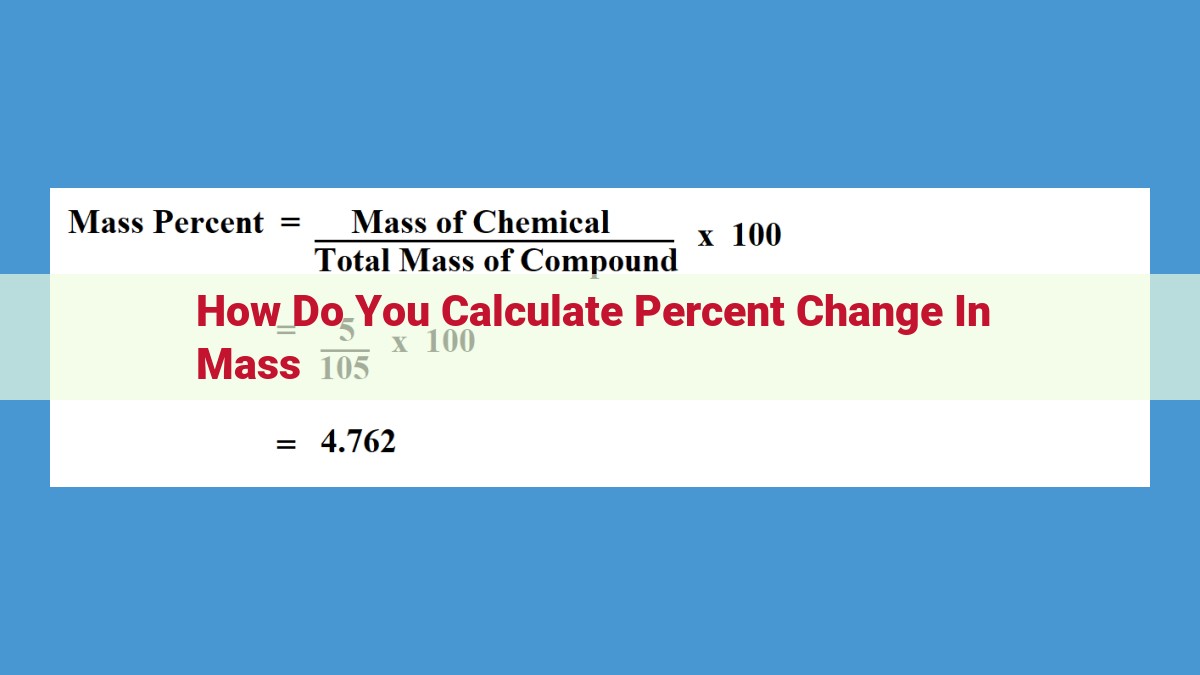To calculate percent change in mass, determine the mass variation (difference between final and initial mass) and express it as an absolute value. Divide the mass variation by the initial mass and multiply by 100 to obtain the percentage change. This formula represents the relative change in mass, which measures the difference in mass relative to the original mass and is expressed as a percentage.
Understanding Percentage Change: A Comprehensive Guide
In the realm of mathematics, percentage change plays a crucial role in quantifying the variation between two values. It’s a concept that finds applications in myriad fields, from finance to science. Understanding percentage change is essential for grasping the significance of changes and variations.
Percentage is a measure that represents a fraction or proportion of a whole. It’s expressed as a number followed by the percentage sign (%). For instance, 50% represents half of a whole.
Relative change is a comparison between two values. It’s determined by dividing the difference between the final and initial values by the initial value. This result is then expressed as a percentage. For example, if the final value is 120 and the initial value is 100, the relative change is:
Relative Change = ((120 - 100) / 100) * 100 = 20%
This implies that the value has increased by 20% relative to its original value.
Variation is another concept closely linked to percentage change. It refers to the absolute difference between the final and initial values. In the above example, the mass variation would be 120 – 100 = 20. It’s interchangeable with the term mass difference.
Understanding Mass: The Essence of Matter
Mass, a fundamental property of all matter, represents the intrinsic amount of stuff in an object. Unlike weight, which is influenced by gravitational forces and varies with location, mass remains constant regardless of where it resides or the strength of the gravitational pull.
Mass: The Invariable Essence
Mass, measured in units such as kilograms or pounds, serves as an unwavering measure of an object’s material content. It quantifies the number of protons and neutrons packed within its atoms, constituting the unyielding essence of the object.
Weight, Volume, Density: Distinct Measures
Although often conflated with mass, weight, volume, and density are distinct concepts. Weight, is the gravitational force acting on an object and varies with location, while volume measures the space occupied by an object. Density, on the other hand, quantifies the mass per unit volume of an object, providing insight into its compactness.
Understanding Mass: Identifying Initial and Final Mass
In the realm of science, mass stands as a fundamental concept, representing the substance or matter that constitutes an object. Unlike weight, which is influenced by gravity, mass remains constant regardless of its location. Its magnitude is measured in units of grams or kilograms.
When analyzing changes in mass, two key terms emerge: initial mass and final mass. Initial mass refers to the mass of an object at the commencement of a process or experiment. It serves as the benchmark against which all subsequent mass changes are measured. Often, initial mass is also referred to as starting mass or original mass.
Grasping the concept of initial mass is crucial for accurately calculating changes in mass. Without a clear understanding of the initial mass, it becomes impossible to determine the extent of mass variation.
Calculating Percent Change in Mass
Calculating percent change in mass is an essential skill in various scientific fields, providing insights into the transformation of matter. To grasp this concept, let’s delve into the fundamental principles behind it.
Defining Percent Change in Mass
Percent change in mass measures the proportionate difference between the final and initial mass of an object. It expresses this difference as a percentage to indicate the extent of the mass change.
Calculating Percent Change in Mass Formula
To calculate percent change in mass, follow this formula:
Percent Change in Mass = ((Final Mass - Initial Mass) / Initial Mass) x 100%
Simply put, find the mass variation (absolute difference between final and initial mass) and divide it by the initial mass. Then, multiply the result by 100 to express it as a percentage.
Mass Variation
Mass variation represents the absolute difference between the final mass and the initial mass. It provides the numerical value of the mass change without considering the direction (increase or decrease).
Interchangeability of Terms
The terms mass difference and mass variation are often used interchangeably. Both refer to the absolute difference between the final and initial mass. However, mass variation highlights the variation or change in mass, while mass difference emphasizes the numerical gap between the two masses. However, keep in mind that any non-zero mass variation would result in a non-zero percent change in mass.
